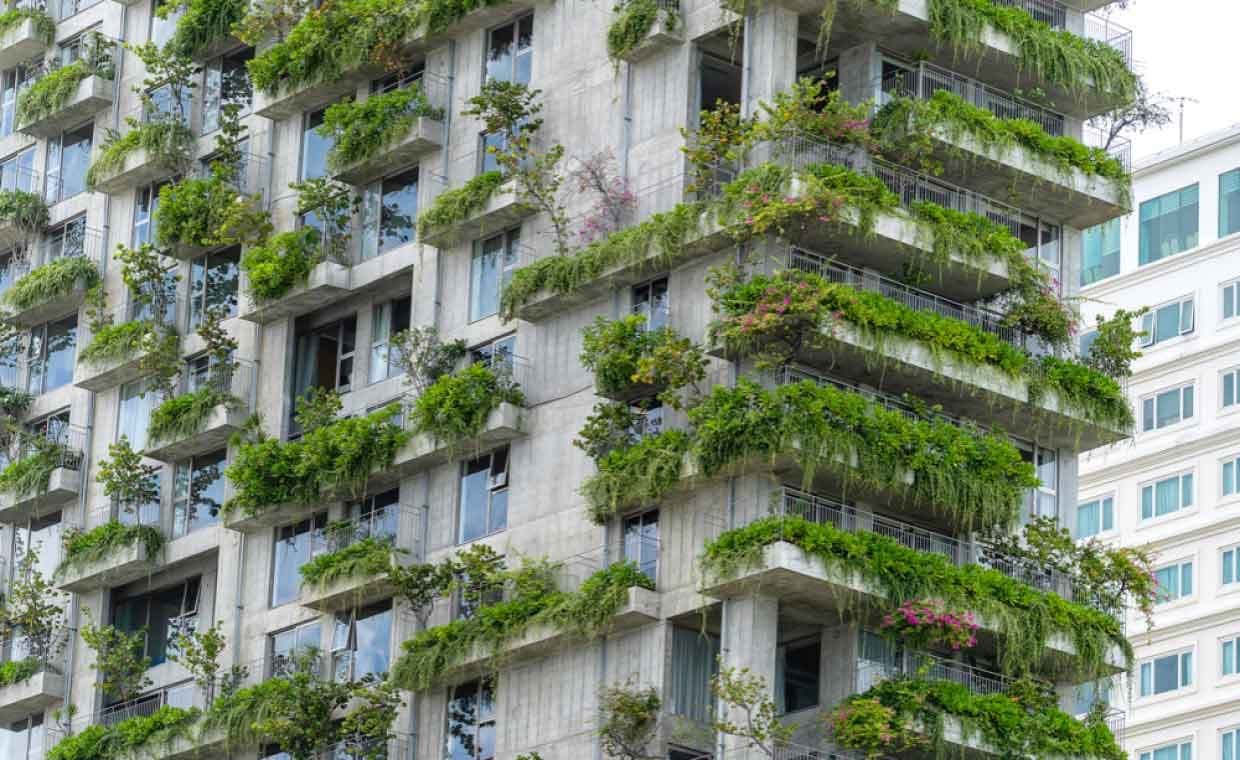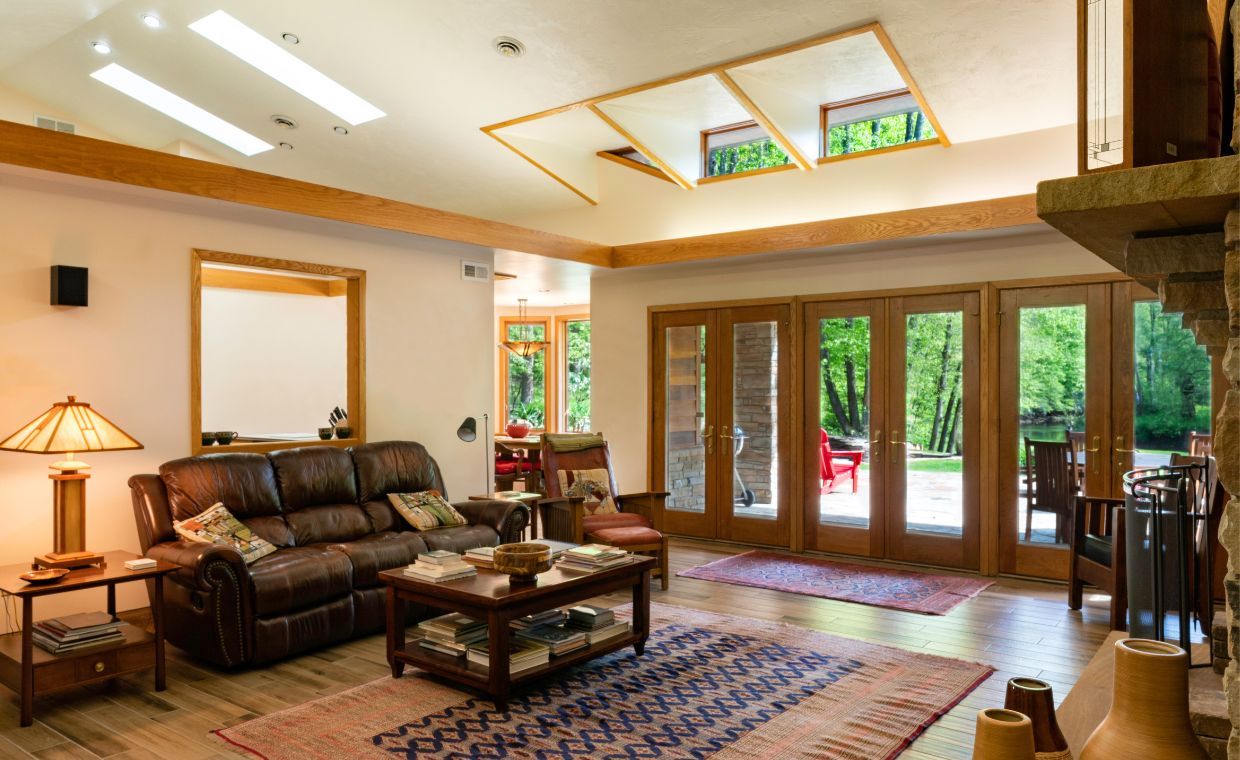
Table of Contents
As per the World Green Building Council about 39% of global greenhouse gas emissions come from buildings, with 28% being solely attributed to mechanical heating and cooling systems.
In response to these challenges, creativity and innovation have converged to develop solutions that promise a greener future. The need for eco-friendly construction has become paramount in today’s world. In this blog, gharpedia explores 14 sustainable design innovations in architecture to inspire you.
1. Space Bubbles by MIT

Courtesy - Oregonlive
Architects have been on a mission to combat climate change, and Carlo Ratti, a prominent member of the MIT research team embraced this responsibility. The team developed the concept of Space Bubbles, designed to float in a layer above the earth to reflect sunlight.
This innovative design could significantly help minimise the effects of global warming, as these Space Bubbles act as a shield against it. “Space-based solutions would be safer – for instance, if we deflect 1.8 percent of incident solar radiation before it hits our planet, we could fully reverse today’s global warming,” mentioned Carlos Ratti.
2. Tree Fork Joints by Massachusets Institute of Technology

Courtesy - Dezeen
Who would have thought that discarded tree forks could serve as renewable and natural alternative in construction? Another promising innovation by MIT involves using load-bearing joints made from tree forks in design projects. This natural material helps minimise the ecological impact of construction methods. The joints can be used as building materials or to add precise details to furniture design.
“If you take a tree fork and slice it down the middle, you see an unbelievable network of fibers that are intertwining to create these often three-dimensional load transfer points in a tree,” mentioned Caitlin Mueller, one of the professors at MIT.
3. Photosynthesis Device by the University of Cambridge

Courtesy - Anthropocene Magazine
Innovation has led to the development of a device that mimics the natural process of photosynthesis. The product is a thin sheet that generates energy like plants, producing oxygen using natural light, carbon dioxide, and formic acid extracted from water.
The sheet is composed of a photocatalyst that absorbs light and triggers a reaction, creating a sustainable energy system with no harmful emissions polluting the atmosphere. The breakthrough has the potential to reduce human dependency on fossil fuels significantly.
“It’s been difficult to achieve artificial photosynthesis with a high degree of selectivity so that you’re converting as much of the sunlight as possible into the fuel you want, rather than be left with a lot of waste. We were surprised how well it worked in terms of its selectivity – it produced almost no by-products,” mentioned Qian Wang, one of the members of the university.
4. Solar Water Purifier by IISc and Suryagen Renewables

Courtesy - The Hindu
The modern eco-friendly technology of solar water purifiers can purify water from any natural source into potable water. The device is economical and carries immense value as it has the potential to offer clean drinking water for contaminated areas.
It uses solar energy to evaporate contaminated water, and the resulting vapour is condensed into pure water. The process leaves behind impurities and germs, ensuring safe and healthy drinking water.
5. Self-Repairing Roads by the Civil Engineering Department at the University of British Columbia

Courtesy - Hindustan Times
Seasonal damage to roads is unavoidable but what if we could construct self-repairing roads? Developed in the labs of the University of British Columbia, this innovative technology uses concrete and a mix of special fibres to ensure sturdy and durable roads.
The composition follows a ratio of 40% cement and 60% fly ash. A hydrophilic nano-coating on the fibres attracts water during the rainy season, which acts as a key component for filling the cracks. The water rehydrates the cement, effectively healing the gaps before they expand.
6. Bio-based Carbon Fibers by the German Institutes of Textile and Fiber Research

Thin, lightweight, and strong threads known as carbon fibres are widely used in manufacturing various products. Traditionally made from fossil fuels, researchers are now exploring greener alternatives. One promising option is lignin, a plant-based raw material and a major by-product discarded by the paper industry.
“The raw materials [for regular carbon fibre] come from petroleum but we’re trying to move away from this,” mentioned Frank, one of the scientists at the institute.
7. Sun-powered Textiles by Aalto University

Courtesy - Anne Kinnunen
What could be better than wearing fabrics with solar panels discreetly integrated into them? Researchers at Finland’s Aalto University have developed a prototype jacket that captures solar energy while maintaining a fashionable look.
The intent was to create a washable energy-efficient clothing (jacket) that could power devices like body sensors to monitor body temperature.
8. Solar Power Tree by the Central Mechanical Engineering Research Institute (CSIR-CMERI)

Courtesy - CSRI - CMERI
A solar power tree has the capability to generate enough electricity to light up five homes while occupying minimal floor space. The solar panels are arranged like branches of trees, with their staggered composition efficiently capturing sunlight to produce clean energy.
9. Emission-free Cement by MIT

Courtesy - Design Indaba
The construction industry faces criticism for its excessive use of cement in designs, which releases greenhouse gases into the atmosphere. A concerted effort by the team at MIT has resulted in the development of emission-free cement.
Sustainable development begins with green materials, which is why this invention is one of the most significant breakthroughs for the design industry. The process of building with this cement includes an additional electrochemical step that captures the carbon dioxide emitted and keeps the environment free from harmful gases. A bonus is that the captured gas can be used to carbonate drinks.
10. Irene Roca Moracia and Brigitte Kock’s Bio-concrete tiles

Courtesy - Dezeen
Japanese knotweed and American crayfish shells have been fused to compose bio-concrete tiles. Both of these materials are known for causing ecological damage, but this threat was seen as an opportunity to offer an eco-friendly building material while also minimising the risks to the ecological balance.
11. Carbon-capturing clothes by DS Automobiles

Courtesy - GQ Magazine
Imagine wearing a fashionable outfit and cleaning the environment as you step out. Sounds unreal, right? Well, researchers at DS Automobiles have turned this into a reality, with apparel like jackets and t-shirts filled with living algae that absorb carbon dioxide from the air and convert it into oxygen. The functionality of these eco-friendly clothes requires proper exposure to sunlight and mist.
“There are hopes that this technology can be incorporated within both the fashion and automotive world as we look towards the future and gain a better understanding of its real-world capabilities,” mentioned the founders who developed the layer of algae for the clothing.
12. CobBauge by British and French Researchers

Courtesy - University of Plymouth
Cob was conventionally composed of a mixture of soil, water, straw, hemp, and other materials. Scientists have developed the latest model of cob also known as cobBauge, which combines different grades of cob (denser and lighter grade) to create a version that can be used as one of the primary construction materials. This new cob not only traps heat but also leaves a minimal carbon footprint.
“While what we have come up with is without a doubt a modern interpretation of cob, we hope it will satisfy both the traditionalists and those looking for a hi-tech, energy-efficient material,” mentioned one of the researchers, Steve Goodhew.
13. 2DPA-1 Plastic by MIT

Courtesy - MIT News
2DPA- is a plastic with twice the strength of steel. The best part? This material is recyclable. This polymer undergoes self-assembly to form sheets, making it extremely durable and malleable. As a sustainable material, it can be used in construction, as it has the potential to reduce energy emissions and consumption.
14. Dew-drop Air Condenser by a Hyderabad Engineering Student

Courtesy - Yahoo News
A dew-drop air condenser system is a 3D-printed device designed to produce water from the air. It provides drinking water using a sensor system that incorporates UV filters. The device can generate up to 1.8 litres of water per hour.
6 Sustainable Tips for Greener Design
The ultimate goal of any design is to create a built-environment that aligns with the ecology of the place as well. Let’s explore a few tips for building green.
1. Choose Low-impact Construction Materials

One of the main contributors to environmental degradation in the construction industry is the material used. One can reduce pollution significantly by opting for eco-friendly materials. There’s a need to move away from the typical concrete structures and adopt recycled and natural materials.
Also Read : 8 Eco Friendly Building Materials Utilised in Green/Sustainable Buildings!
2. Install Cool Roof and Cut Down on Energy bills

HVAC systems are the largest contributors to greenhouse gas emissions in buildings. The innovative cool roof technique aids in cutting down the need for mechanical cooling by minimising heat gain through the use of reflective roofing materials. Managing interior temperature with a smart design approach not only cuts down on energy consumption but also reduces costs.
3. Incorporate Renewable Energy Systems

Designers can opt for renewable systems like solar panels and geothermal systems. Even a small addition can be highly beneficial in the long run due to its eco-friendliness. These systems not only make the design more sustainable but also offer a comfortable living environment for the users.
Also Read : How Can Solar Energy Help Save the Environment
4. Adopt Rainwater Harvesting

Rainwater harvesting has been emphasised several times in the past, and it still continues to be an important consideration in designs. Integrating these systems into designs is essential for conserving water.
5. Invite Modular Construction Technology

The sustainability quotient of a project can be further enhanced through modular construction techniques. Components of the design can be developed as individual modules and then assembled on-site. This approach promotes sustainability by minimising material waste and enabling the reuse of various tools and resources.
Also Read : Everything you need to know about Modular and Prefabrication Construction Techniques
6. Integrate Smart Buildings Technologies

With the latest technology, products and appliances have become far smarter and have proven to save energy in most projects. Intelligent systems regulate interior temperatures based on weather conditions, reducing both energy consumption and operational costs.
Also Read : Smart Homes: 10+ Benefits of Home Automation Technology!
Top 6 Sustainable Projects across the Globe
1. Northernmost Energy-Positive Building, Norway
The office building by Snohetta Architecture in Norway is one of the most energy-positive buildings in the world. A blend of advanced technologies minimises energy consumption and steers the structure towards sustainability. The facade and roof are equipped with solar panels that generate electricity for both on-site use and supply to neighbouring buildings.
2. Low-Income Homes in Las Vegas
A low-income house doesn’t necessarily mean compromised quality. Geoship, a California-based startup, is pioneering the construction of bioceramic domes. The material is extracted from the wastewater and moulded into structures resembling footballs. The energy-efficient setup is resilient to natural calamities and has a lifespan of over 500 years. One of the most remarkable features of this innovation is bioceramic’s ability to absorb carbon dioxide.
3. Smart Forest City, Mexico
Stefano Boeri has envisioned a forest city in Mexico that is eco-efficient. The proposal aims to house 130,000 people in houses covered with plants. Spanning an area of 557 hectares, the site will feature over 7.5 million plants. Apart from its natural elements, the city will be equipped with solar panels and water management systems to achieve sustainability goals.
4. Living Wall with 400,000 Plants, Europe
Shepherd Robson, an architectural firm, plans to cover the facade of a building with plants. This will be the largest living wall in all of Europe, with more than 400,000 plants resting on the surface. Apart from the breathing wall, this facade also aims to feature a rainwater harvesting system to sustain the plants.
5. Pop-up Bistro in Manhattan
A pop-up bistro in Manhattan City is entirely built from recyclable materials. The design was envisioned and executed by Linda Bergroth and Harri Koskinen. The primary materials used in the construction were recycled food packaging, along with local ingredients. In addition to offering a great dining experience, the bistro is also known for hosting various talks on zero waste.
6. Floating Home for Coastal Community
The concept of floating homes was developed for the coastal communities as it offers self-sustaining homes. The two-story structure operates on renewable energy and provides a solution to rising sea levels. These homes can be arranged in clusters and placed a few meters from the coastline.
Multiple communities could come together to live and form a large neighbourhood setting. Each module functions on solar and electric energy and has a system to manage, filter, and store water.
Here’s a video to sum up all the points mentioned above:
Keep it Green!
In the modern world, not only must the designs be green, but the innovations as well. If the basic components are inclined towards sustainability, the end result can be extremely promising. For the past few years, the notion of sustainability has been in the limelight, which needs to be adopted as a building code rather than being a mere trend.
Sustainable design inventions in architecture are healthy for the environment and offer a comfortable living space for the users. Adoption of these innovations as basic building practices can save you from hefty bills as well. Start small, keep going, and build green!
Also Read:
Living Building Materials: Transforming Construction with Sustainable Innovation
8 Eco Friendly Building Materials Utilised in Green/Sustainable Buildings!
Author Bio
Saili Sawantt – She is an Architect and Interior Designer by profession. Writing is what she treats as her passion. She has worked as an Architectural Writer, Editor, and Journalist for various design as well as digital portals, both national and international. Formerly she has also worked with Godrej Properties Limited (GPL) Design Studio, Mumbai, due to her keen interested in learning about Sustainability and Green buildings. Apart from this, she runs her blog ‘The Reader’s Express’ and is a practicing Architect & Interior Designer.






























